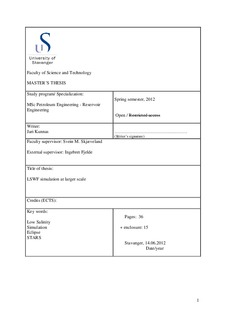| dc.contributor.author | Kunnas, Jari | |
| dc.date.accessioned | 2012-11-09T15:31:18Z | |
| dc.date.available | 2012-11-09T15:31:18Z | |
| dc.date.issued | 2012 | |
| dc.identifier.uri | http://hdl.handle.net/11250/183434 | |
| dc.description | Master's thesis in Petroleum engineering | no_NO |
| dc.description.abstract | Low salinity water flooding is a field of science that is new and need more research to find a definite theory of what happens. There have not been done many modeling studies on this field.
The objective of my thesis is to evaluate whether existing commercial reservoir simulators can be used to translate laboratory results into field scale estimates.
The method of doing this was to simulate a core flooding using Schlumberger’s “Eclipse 100” and Computer modeling group’s “STARS”. The model proposed by Omekeh et al. (2012) was attempted to be recreated in the simulators.
The “Eclipse 100” software uses a model proposed by Jerauld et al. (2008), which changes the relative permeability curves based on total salinity in the core or reservoir. And therefore is not able to recreate the ion exchange effect.
STARS also lacked the possibility to simulate the effect modeled by Omekeh et al. (2012), because it did not allow the interpolation of relative permeability curves to be based on a solid component that decreases due to desorption.
The STARS simulator can be able to reproduce the effect if they reprogram the software so that interpolating based on the concentration of solid components is possible. | no_NO |
| dc.language.iso | eng | no_NO |
| dc.publisher | University of Stavanger, Norway | no_NO |
| dc.relation.ispartofseries | Masteroppgave/UIS-TN-IPT/2012; | |
| dc.subject | petroleumsteknologi | no_NO |
| dc.subject | reservoarteknologi | no_NO |
| dc.subject | low salinity | no_NO |
| dc.subject | simulation | no_NO |
| dc.title | LWSF simulation at larger scale | no_NO |
| dc.type | Master thesis | no_NO |
| dc.subject.nsi | VDP::Technology: 500::Rock and petroleum disciplines: 510::Petroleum engineering: 512 | no_NO |
